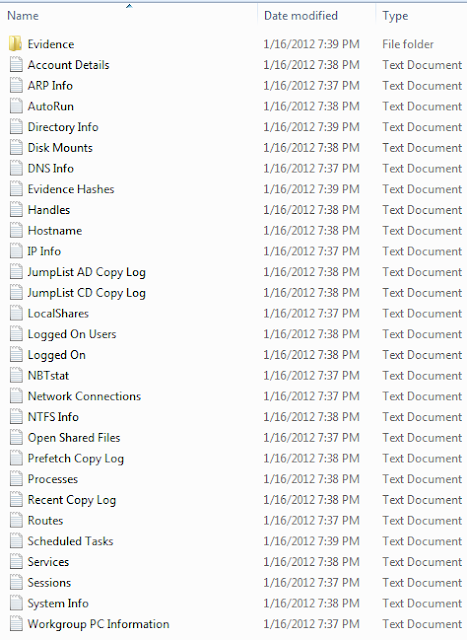A New Utility
Well, it has been awhile since my last post. I have been busy finishing up Capstone course work at Davenport University. For my Capstone project I selected to focus on digital forensics and created a workstation for evidence examination with a Windows 7 host. On top of that, I elected to create a script that would perform basic triage functions with known commands and utilities. I developed the script with the AutoIt language based on a recommendation from a friend. The course allowed me to develop a proof-of-concept application that did quite a bit, but it did it very poorly. So a few long nights later, I re-did it all and made it work a bit better and do a few more interesting things, discussed later. After reading Corey Harrell's recent blog post about his new script, I decided I would share my tool as well since it's a small way I can contribute to the community I love.
I've posted the project on Google Code here: http://code.google.com/p/triage-ir/
The Requirements
As I mentioned previously, the script I created utilizes other applications to function. First off, it utilizes your standard 'cmd.exe' from the Windows system (found at C:\Windows\System32). Eventually, I hope to make it so it doesn't need a copy of the command prompt in the folder but the syntax in the script does not seem to be working properly at this point.So the application folder will look something like this:
You will notice that there is also a tools folder. This, obviously, will be where I have the tools required for the script stored. Unfortunately for licensing reasons, I do not include the tools needed. The tools are free, so you can download them as follows:
- Sysinternals Suite - Mark Russinovich
- DumpIt - MoonSols
- MD5DEEP & SHA1DEEP - Jesse Kornblum
The Function
The script is designed to perform basic triage commands, as well as acquire evidence automatically on the system. I designed the script to be ran from a flash drive, but you can really run it from anywhere. All reports and evidence will be collected in the script directory under a Incident folder with a time stamp ("mm-dd-yy Incident"). The tool should perform the following functions:
- Gather Information on
- System Information
- Running Processes
- Services Information
- NTFS Information
- Mounted Disks
- Directory Structure
- Scheduled Tasks
- AutoRun
- Account Settings
- Logged in Users
- IP Configuration
- Routes
- Active Connections
- ARP
- DNS
- NETBIOS
- Network Shares
- Shared Files
- Connected Sessions
- Workgroup PCs
- Capture Evidence
- Prefetch
- Recent Folder
- Jump Lists (Windows 7)
- SYSTEM hive
- SECURITY hive
- SAM hive
- SOFTWARE hive
- Current User NTUSER.DAT
- All user's NTUSER.DAT
- Random Access Memory
- Preserve Data
- MD5 Hashing
- SHA1 Hashing
All of this contained in a simplified graphical user interface. Many of the commands are modular so you can choose what commands and what items you wish to run or capture, with a simple check box. When you run the script you should get to see something like this:
The Results
Once you've selected your choice of modules you simply hit run and then you will see a new folder created in the script folder named "mm-dd-yy Incident". This folder if you run everything you will see something like this:
You'll get a lot of information regarding the PC you run the tool on. All of it sectional going to its own report. This was the easiest way for me to setup reporting. My hope is to someday create a centralized html file for easy access to all of the information in an easily navigated web page. The evidence folder is where you'll find all of your stored data. It will look a little like this:
You should find copies (used robocopy to retain metadata settings, I hope) of the Recent Folder, Prefetch Folder, and Jump List folders if you are in Windows 7. You will also notice it can rip all of your registry hives for quick analysis with your favorite tool. Considering adding a Reg Ripper module so you can get quicker reports from extracted registry data.
Future
Full disclosure, this script is a work in progress at the moment. I can't promise it will work for everyone. I'm hoping some of you will be kind enough to test it out and send me your feedback and errors so I can hopefully ensure reliability of it. Also, if you have ideas that you would like to see implemented within the script just let me know and I will try to implement them properly. As of right now, I am simply continuing to work on getting the script to run without the copied command prompt and adjusting the tool to a better order of volatility when executing the commands. Also I need to add some sort of progress monitoring and clean up execution windows a bit. Any and all suggestions are welcomed! You may contact me at: michael.ahrendt@gmail.com
Again, you may download the script here. You can choose to just use the executable or, if you have AutoIt, you can run from the source code of the same name.
Hope you enjoy.




